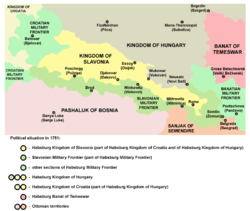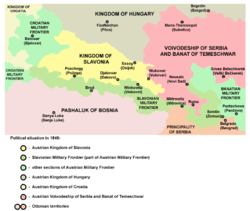Kingdom of Slavonia
| Kingdom of Slavonia | ||||||
| Separate Habsburg land under joint civil-military administration (1699–1745),[1] Land of the Crown of St Stephen within the Habsburg Monarchy (1745–1804)a Constituent land of the Austrian Empire (1804–1868)a | ||||||
| ||||||
| ||||||
 Kingdom of Slavonia in 1751, shown in yellow | ||||||
| Capital | Osijek | |||||
| Languages | Official: Latin (until 1784; 1790–1847) German (1784–1790) Croatian (1847–1868) | |||||
| Religion | ||||||
| Government | Monarchy | |||||
| Ban (Viceroy) | ||||||
| - | 1699–1703 | Adam Batthyány (first) | ||||
| - | 1848–1859 | Josip Jelačić (notable) | ||||
| - | 1867–1868 | Levin Rauch (last) | ||||
| Legislature | Sabor | |||||
| Historical era | Early modern period | |||||
| - | Established | 1699 | ||||
| - | Joined with Croatia into Croatia-Slavonia | 1868 | ||||
| Area | ||||||
| - | 1868 | 9,246 km² (3,570 sq mi) | ||||
| Population | ||||||
| - | 1868 est. | 381,480 | ||||
| Density | 41.3 /km² (106.9 /sq mi) | |||||
| Currency | Gulden | |||||
| Today part of | | |||||
| A: Subordinate to the Kingdom of Croatia and to the Kingdom of Hungary (1745–1849), separate Habsburg land (1849–1868) | ||||||
Part of a series on the |
|---|
| History of Slavonia |
.png) |
|
Antiquity
|
|
Medieval
|
|
Ottoman Empire |
|
Habsburg Monarchy |
|
20th century |

The Kingdom of Slavonia (Croatian: Kraljevina Slavonija; German: Königreich Slawonien; Latin: Regnum Sclavoniae; Hungarian: Szlavón Királyság) was a province of the Habsburg Monarchy and the Austrian Empire that existed from 1699 to 1868. The province included northern parts of present-day regions of Slavonia (today in Croatia) and Syrmia (today in Serbia and Croatia). The southern parts of these regions were part of the Slavonian Military Frontier.
Geography
The Kingdom of Slavonia was bounded on the west by Kingdom of Croatia to the west, Kingdom of Hungary on the north and the east and on the south by the Ottoman Empire. Together with the Slavonian Military Frontier it had about 6600 sq. miles. It was divided into three counties of Požega, Virovitica and Syrmia. Besides a chain of mountains in the middle of the province, the remaining part of Slavonian Kingdom consisted of fertile eminences planted with vines and fruittrees and extensive plains.[2]
History
The Kingdom of Slavonia was formed from territories that Habsburg Monarchy gained from Ottoman Empire by the Treaty of Karlowitz (1699). Initially, it was a separate Habsburg land under joint civil-military administration that lasted from 1699 to 1745.[3] The inhabitants were exempted from taxes, but were bound to military service.[2] In 1745, the full civil administration was introduced and Kingdom of Slavonia, as one of the Lands of the Crown of St. Stephen, was administratively included into both, the Habsburg Kingdom of Croatia, and the Habsburg Kingdom of Hungary. After 1849 the Kingdom of Slavonia and Kingdom of Croatia were affirmed as completely separate crownlands (constituent lands) of the Austrian Empire. Following the 1868 Settlement (Nagodba) with the Kingdom of Hungary, Kingdom of Slavonia was joined with Kingdom of Croatia into the single Kingdom of Croatia-Slavonia, which although it was under the suzerainty of the Crown of Saint Stephen kept a significant level of self-rule.
Population
The 1802 Austrian population data for the Kingdom of Slavonia recorded 148,000 (51,6%) Catholics, 135,000 (47.2%) Orthodox and 3,500 (1.2%) Protestants.[4]
According to other statistical estimations, in 1787 in civil Slavonia there were 265,670 inhabitants, and in 1804/1805 there were 286,349 inhabitants, but from that number clergy and nobility were excluded. Only men were counted in that census. There were: 74,671 Roman Catholics, 68,390 Orthodox Christians, 1,744 Calvinists, 97 Lutherans and 160 Jews. Number of Orthodox Christians was higher in Syrmia: 32,090 Orthodox Christians and 12,633 Roman Catholics. In other two counties of Slavonia: Požega and Virovitica, as in city of Požega, Roman Catholics outnumbered Orthodox population.
The official Austrian census of 1857 for Kingdom of Slavonia gives the following results (a section of Syrmia was in 1857 part of the Voivodeship of Serbia and Banat of Temeschwar):[5]
- 63,341 Roman Catholics
- 41,172 Eastern Orthodox
- 837 Jews
- 629 Greek Catholics
- 85 Calvinists
- 44 Lutherans
Osijek County
- 101,559 Roman Catholics
- 35,806 Eastern Orthodox
- 4,257 Calvinists
- 1,784 Jews
- 629 Greek Catholics
- 69 Lutherans
Economy
The Kingdom of Slavonia was mostly an agricultural land, just like Kingdom of Croatia, and it was known for its silk profuction. Agriculture and the breeding of cattle were the most profitable occupations of the inhabitants. It produced corn of all kinds, hemp, flax, tobacco, and great quantities of liquorice. The quantity of wine produced was also large, especially in the county of Srijem. In 1857 industrial employment (11,01%) was highest in the County of Osijek, while 72,3% were employed in agriculture (82,9% in the Požega County).[6][2]
See also
- Kingdom of Croatia (Habsburg)
- Sanjak of Požega
- Slavonian Military Frontier
- Kingdom of Dalmatia
- Timeline of Croatian history
References
- ↑ John R. Lampe (1982). John R. Lampe and Marvin R. Jackson, ed. Balkan economic history, 1550–1950: from imperial borderlands to developing nations. Indiana University Press. p. 63. ISBN 978-0-2533-0368-4.
- ↑ 2.0 2.1 2.2 Society for the Diffusion of Useful Knowledge: The Penny Cyclopaedia of the Society for the Diffusion of Useful Knowledge, vol 22, p. 100-101
- ↑ Balkan economic history, 1550-1950: from imperial borderlands to developing nations, John R. Lampe, Marvin R. Jackson, Indiana University Press, 1982, page 63.
- ↑ Mladen Lorković, Narod i zemlja Hrvata, reprint, Split, 2005., page 86
- ↑ Statistische übersichten über die bevölkerung und den viehstand von Österreich nach der zählung vom 31. october 1857, page 120
- ↑ Mariann Nagy - Croatia in the Economic Structure of the Habsburg Empire in the Light of the 1857 Census, page 88
